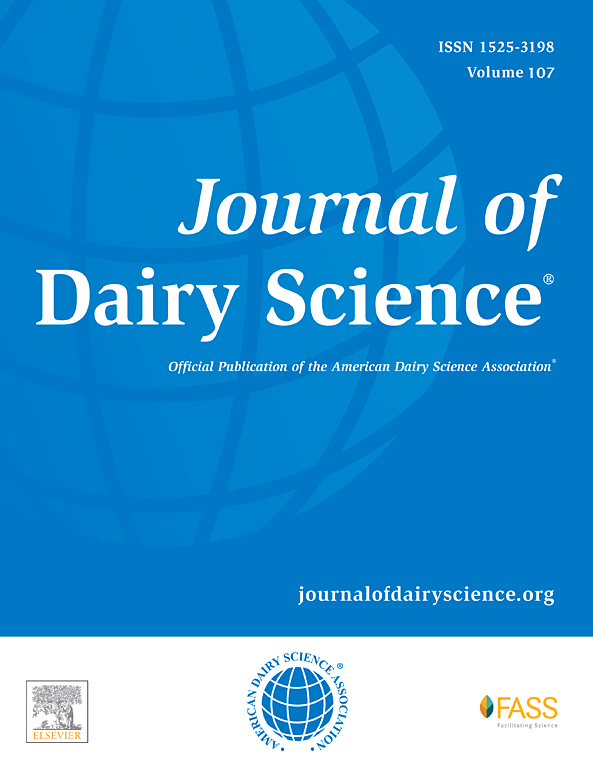甲烷抑制剂对高、低肠道甲烷排放奶牛体外瘤胃发酵和微生物组成的影响
IF 4.4
1区 农林科学
Q1 AGRICULTURE, DAIRY & ANIMAL SCIENCE
引用次数: 0
摘要
本研究的目的是研究瘤胃接种物类型(从高或低甲烷排放表型奶牛获得)和有效的抗甲烷化合物(AMC),包括溴仿(CHBr3)、3-硝基丙酸(3NPA)、氯仿和大红藻(RM)对体外产气、瘤胃发酵和微生物组成参数的相互作用。初步筛选了68头泌乳中期荷斯坦奶牛的肠道CH4排放量。68头奶牛中,2头为CH4高排放(HM, 24.8±0.05 g CH4/kg DMI), 2头为CH4低排放(LM, 14.8±0.45 g CH4/kg DMI)。这些奶牛被用作体外实验的接种供体。体外分批培养24 h。实验采用2 × 5因子设计,接种量和抑制剂处理为自变量,其相互作用纳入模型。产气参数方面,AMC -接种型(INOC)相互作用对总产气量、CH4产率(g/mg TMR)和总气中CH4浓度有显著影响。阴性对照处理(TMR + LMI或不添加AMC的HMI接种)中,低CH4接种量(LMI)与高CH4接种量(HMI)产生的总气体CH4浓度相似。与LMI相比,无论处理方式如何,HMI的总产气量都要低21%。在本研究中,乙酸和丙酸的摩尔比及其比值也有显著的AMC × INOC相互作用。所有AMC的加入导致乙酸的减少和丙酸和丁酸摩尔比的增加。在所研究的抑制剂中,3NPA与LMI而不是与HMI联合时,倾向于导致更大的CH4还原,醋酸盐还原和丙酸浓度增加。一种大型藻类抑制剂与HMI(而非LMI)联合使用可降低CH4和提高丙酸浓度。LMI接种量和各AMC包埋量均导致丁酸盐摩尔比增加。对产甲烷古菌的产甲烷活性估计,INOC与AMC之间没有显著的交互作用。低ch4表型奶牛接种后,反刍甲烷预防菌和stadtathanosphaera基因拷贝数较高。在细菌群落中,22个类群与INOC有显著的交互作用。每种AMC对产甲烷菌和单个细菌的影响不同,改变了H2通量。无论接种量如何,CHBr3和3NPA对产甲烷菌群和细菌群落的改变程度都大于其他AMC。与HMI联合3NPA和HMI联合RM相比,HMI联合3NPA和LMI联合RM的CH4减少量更大,这表明不同的AMC可能比LMI更有效地减少HMI的肠道CH4。这些结果表明,AMC与INOC之间可能存在协同效应;然而,由于INOC难以划分为LMI或HMI,因此应谨慎解释研究结果。本文章由计算机程序翻译,如有差异,请以英文原文为准。
Effects of methane inhibitors on ruminal fermentation and microbial composition in vitro using inoculum from phenotypically high- and low-enteric-methane-emitting cows
The objective of this study was to investigate the interaction of ruminal inoculum type (obtained from high- or low-CH4-emitting-phenotype cows) and potent antimethanogenic compounds (AMC), including bromoform (CHBr3), 3-nitropropionic acid (3NPA), chloroform, and Rhodophyta macroalga (RM) on in vitro gas production, ruminal fermentation, and microbial composition parameters. Sixty-eight mid-lactation Holstein cows were initially screened for their enteric CH4 emissions. Out of these 68 cows, 2 were designated as high- (HM, 24.8 ± 0.05 g CH4/kg of DMI) and 2 as low- (LM, 14.8 ± 0.45 g CH4/kg of DMI) CH4 emitters. These cows were used as inoculum donors for the in vitro experiment. In vitro batch-culture incubations were carried out for 24 h. The experiment was a 2 × 5 factorial arrangement design with inoculum and inhibitor treatments as independent variables and their interaction included in the model. For gas production parameters, the AMC × inoculum type (INOC) interactions were significant for total gas production, CH4 yield (g/mg of TMR), and CH4 concentration in total gas. The low-CH4 inoculum (LMI) resulted in similar CH4 concentration in total gas as the high-CH4 inoculum (HMI) for the negative control treatment (TMR + LMI or HMI inoculum with no AMC added). Total gas production was 21% lower for HMI when compared with LMI, regardless of the treatment. Acetate and propionate molar proportions and their ratio also had a significant AMC × INOC interaction in the current study. The inclusion of all AMC resulted in a decrease in acetate and an increase in propionate and butyrate molar proportions. Of the studied inhibitors, 3NPA tended to result in a greater CH4 reduction, reduced acetate, and increased propionate concentrations when combined with LMI, rather than with HMI. A macroalgae inhibitor in combination with HMI, but not LMI, resulted in lower CH4 and higher propionate concentration. Both LMI inoculum and inclusion of each AMC resulted in increased butyrate molar proportions. There was no significant INOC × AMC interaction for estimates of methanogenic activity of methanogenic archaea. Inoculum from low-CH4-phenotype cows resulted in higher gene copy number of Methanobrevibacter ruminantium and Methanosphaera stadtmanae. In the bacterial community, 22 taxa had a significant interaction with INOC. Each AMC differentially affected methanogens and individual bacteria, altering H2 fluxes. Regardless of the inoculum, CHBr3 and 3NPA altered both methanogenic and bacterial communities to a greater extent than the rest of the AMC. The combination of LMI with 3NPA and HMI with RM resulted in a greater CH4 reduction than HMI with 3NPA and LMI with RM, indicating that a different AMC may be more effective in reducing enteric CH4 in HMI versus LMI. These results indicate that the synergistic effect between AMC and INOC are possible; however, due to the difficulty in classification of INOC as LMI or HMI, results of the study should be interpreted with caution.
求助全文
通过发布文献求助,成功后即可免费获取论文全文。
去求助
来源期刊

Journal of Dairy Science
农林科学-奶制品与动物科学
CiteScore
7.90
自引率
17.10%
发文量
784
审稿时长
4.2 months
期刊介绍:
The official journal of the American Dairy Science Association®, Journal of Dairy Science® (JDS) is the leading peer-reviewed general dairy research journal in the world. JDS readers represent education, industry, and government agencies in more than 70 countries with interests in biochemistry, breeding, economics, engineering, environment, food science, genetics, microbiology, nutrition, pathology, physiology, processing, public health, quality assurance, and sanitation.
 求助内容:
求助内容: 应助结果提醒方式:
应助结果提醒方式:


